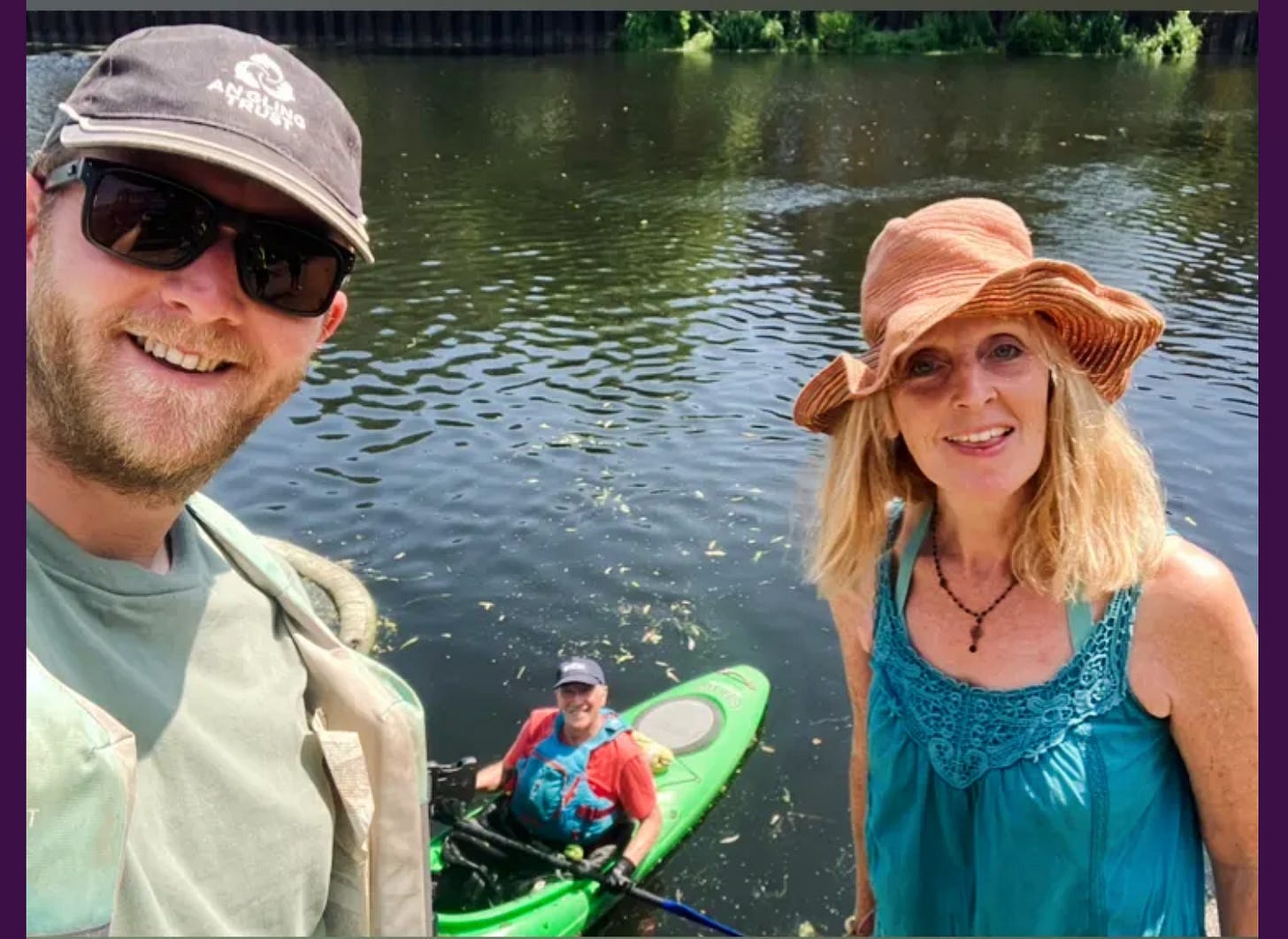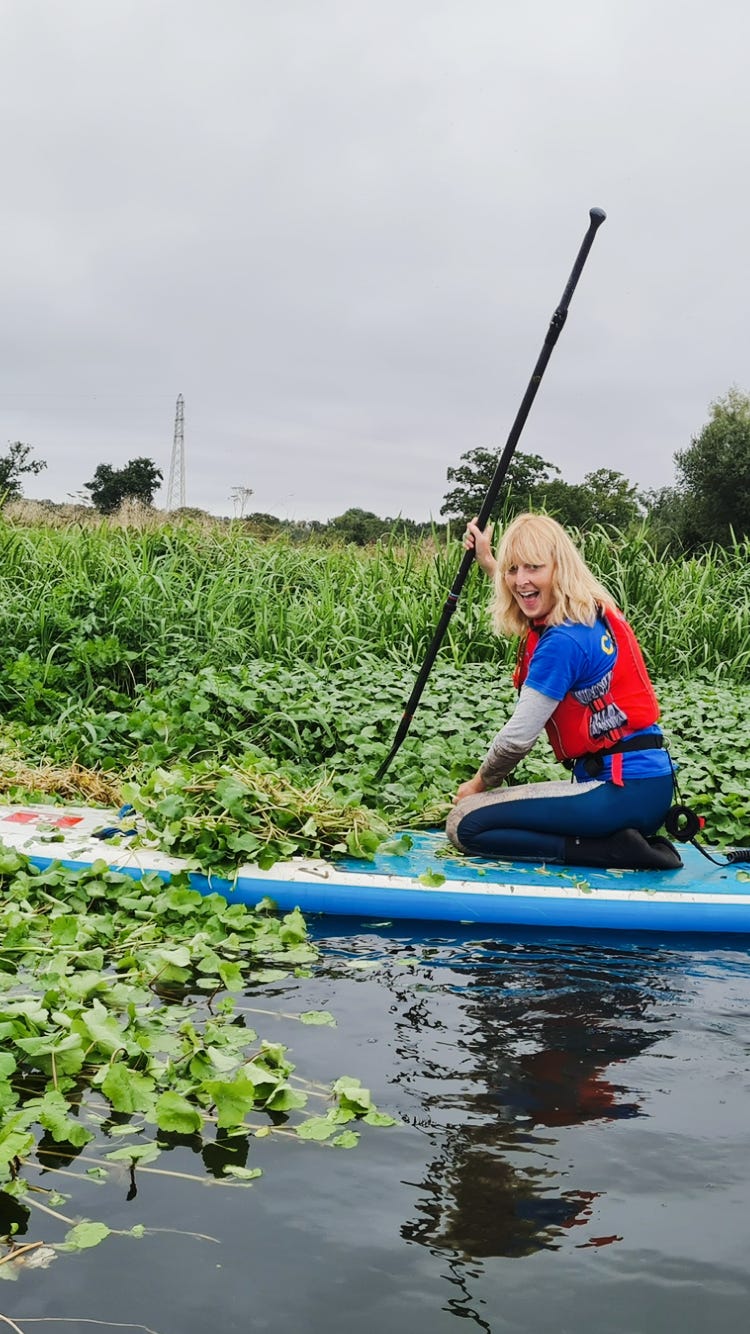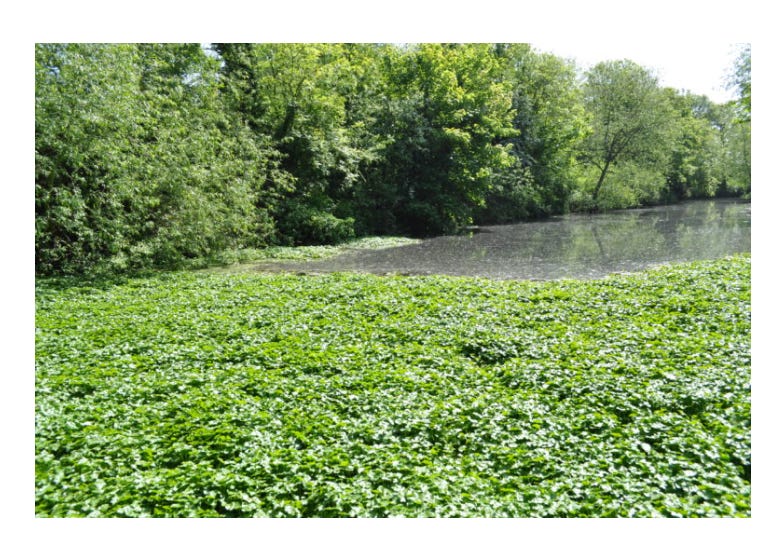Interview: Pip Rowlandson on removing floating pennywort
River lessons from Pip Rowlandson who's aiming to clear the Lea of floating pennywort - with your help

Pippa Rowlandson is in a three-day a week battle of wits against a Dr Who like monster. For the past year Pip’s been working for British Canoeing (in a partnership with the Angling Trust) to rid the Lea Navigation of this green alien which is determinedly taking over the waterways - floating pennywort.
During 2023, 250 volunteers have taken part in 13 events and removed 24 tonnes of the invasive and non-native plant from the Lea. Reference.
Originally this was part of a legacy project for the World Slalom Championships, held September 2023, to tackle litter and making people aware of floating pennywort on the Lea, “but because it’s a bigger beast than they realised we got a bit more money from Environment Agency and now there’s an opportunity to hopefully extend it more,” she says.
Working with partners British Canoeing and the Angling Trust, the dream is to clear the Lea of floating pennywort right down to Limehouse where it meets the River Thames.
That’s not an easy task as it can grow 20cm a day.

Can’t go through it!
Have you ever tried to paddleboard through floating pennywort?
Most paddleboarders are all too aware that canals and rivers can be choked by great mats of this invasive species. To me it looks a bit plumper than watercress, although it’s not something people eat.
In fact, floating pennywort is a north American plant which was introduced to the UK in the 1980s by the aquatic nursery trade (though it’s now banned). Incredibly it can grow up to 20cm a day, and doesn’t die back during British winters. This means floating pennywort can block waterways, choke water flow, crowd out native plants and reduces the amount of oxygen in the water which is detrimental for all the waterways’ inhabitants including fish, aquatic plants and insects who are already having to adapt to the challenges caused by our warming planet (climate change).
Even leaving a small bit of stalk in the water allows the plant to continue growing.
“On the Lea Navigation, there’s a huge project getting rid of floating pennywort,” says Pip Rowlandson over Zoom, fresh from the Waterways Management show. “I’ve been engaging with loads of paddlesports clubs and running corporate days over the last year, but there’s still a lot still to clear,” she says.
River lesson #1: go with the flow
“A river is a river is a river, so we don’t do a little bit here and there, we’re methodically working with the flow. When a section is cleared, we pick all the little tiny strands and know it’s not coming back,” explain Pippa who is a keen kayaker spending her days off on a K1 kayak exploring her local river, the Wey in Guildford
No chemicals are used to remove floating pennywort, but sometimes mechanical removal is essential. “Once it’s cleared by the mechanical digger canoeists and paddleboarders zoom in and take the fragments on the same day. If we do any clearing lower down the river it will just reinfect from this creek, as every time there’s a storm it breaks away.
River lesson #2: be systematic
To date the top of the river down Waltham Gate to Enfield Lock has been cleared. Next phase will see the Clear Access Clear Waters volunteers go from Enfield Lock, where the Canal & River Trust have a boat yard, to Stonebridge Lock, near Tottenham, and then from Tottenham to Leaside Trust in Hackney.
Right now the partners are working with Enfield Council to mechanically remove a large amount of floating pennywort in Mossops Creek which is deep in floating pennywort. “We’ve had two goes at clearing it, with loads of volunteers (around 30 worked all day on 18 October 2023), but it needs mechanical removal before we go downstream,” she says “and during this time I’m recruiting local volunteers to help us go in after the removal and get the tiny strands and remnants in canoes.
“I love this job, I like organising things, love working with volunteers and being in a kayak on the water,” says Pip who began paddling seven years ago. “I got interested in the environmental side because by default you help out. I’d done the litter picks and river cleans on the River Wey, near my home, and found I really enjoyed clearing the river – but this job is on a completely different river so I’ve had to learn the river,” says Pip who also works as a mosaic workshop facilitator in events and festivals
Many of those river lessons have come from the Woosh Explore Canoe Club who have successfully cleared the River Stort of floating pennywort. “It’s their methodology we are copying,” says Pip. “The key to it is getting local groups to almost be guardians of the river – if they see the little threads of floating pennywort then they will remove them - we call it forensic removal.”

River lesson #3: eco-safe behaviour
Pip doesn’t just co-ordinate floating pennywort clearing days she also has a big role modelling eco-safe behaviour. “My role is to educate paddlers and anglers to check, clean, dry and if they are going to different rivers then it is wise to wash down your boat before taking it into another. If we are doing a floating pennywort day we hose down afterwards and are really careful about biosecurity.”
For the paddlers downstream the process seems slow. The Lea Navigation near the London Stadium gets super clogged with a green carpet of floating pennywort. But Pip is clear that it has to be done strategically. “You have to be methodical when working with a river. I’m dictated by nature. You can have a massive storm and everything taken out of the river,” but mostly you need to progress slowly downstream.
There’s also wildlife welfare to consider. “Coots nest May-September so we have to avoid the nests. That’s why the more floating pennywort we get in the winter the better. It doesn’t die back, but we can attack the mats. It doesn’t stop, it’s still growing, it’s a magic crazy plant,” she says with some awe.
And that’s exactly how you’d expect a paddler like Pip, with nature at the heart of her brief, to be – working with the river.
Want to help out?
You can join Pip and Drew for river clearing events by looking at their Facebook page, Clear Access Clear Waters (next is morning of 14 December 2023 at Enfield Lock). Also if you would like to run your own team building you could come and help clear the river. “It's a fun day,” promises Pip.
Look on Clear Access Clear Waters facebook page






